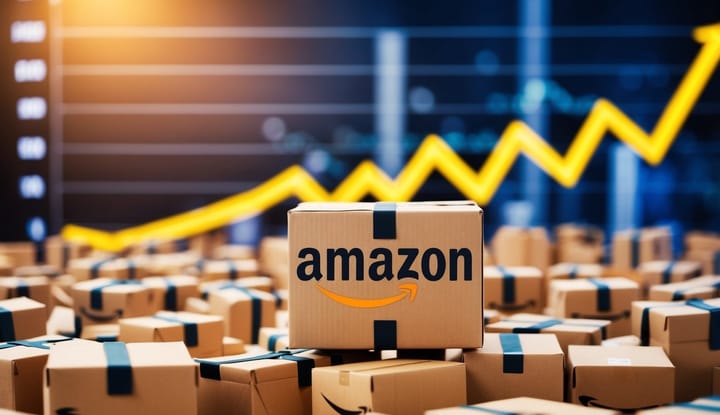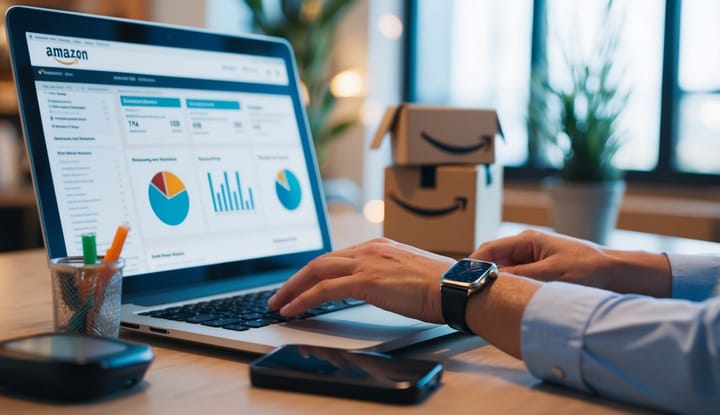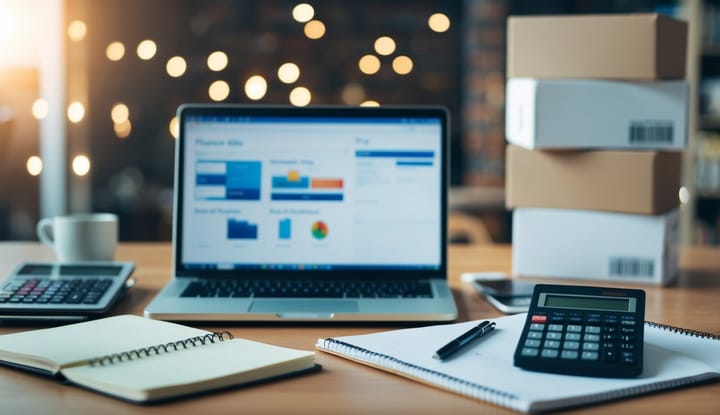2024 Amazon Seller Statistics: FBA Success & Revenue Trends

Amazon FBA has become a dominant force in e-commerce, transforming how people sell products online. The platform's reach extends to millions of sellers worldwide, with over 9.7 million active sellers in 2024. These sellers use Amazon's vast infrastructure to store, pack, and ship their products to customers.

82% of Amazon sellers choose FBA (Fulfillment by Amazon) as their preferred method, and 64% of them achieve profitability within their first year of operation. This success rate shows why many entrepreneurs pick FBA as their business model. The platform's built-in customer base and established logistics network make it easier for new sellers to start and grow their businesses.
US-based sellers moved an impressive 4.5 billion items through Amazon in 2023, averaging 8,600 sales per minute. Many sellers report profit margins between 11-25%, demonstrating the real income potential for those who master the FBA system.
Key Takeaways
- Amazon FBA serves over 9.7 million global sellers with 82% using the fulfillment service
- Most FBA sellers achieve profitability within 12 months of starting their business
- US sellers move thousands of products per minute with healthy profit margins between 11-25%
Overview of Amazon FBA Statistics
Amazon FBA dominates e-commerce fulfillment with 86% of Amazon sellers using the service in 2024. This massive adoption rate comes from high profit margins and efficient delivery systems.
Key Industry Metrics
Amazon FBA hosts 9.7 million sellers worldwide, with 1.9 million actively selling products. The platform adds about 3,700 new sellers daily.
Most FBA sellers earn profit margins between 15-20%, showing strong business potential. Top performers reach margins above 20%.
82% of brands and businesses choose FBA over Fulfillment by Merchant (FBM) services. This preference stems from FBA's integrated shipping and customer service benefits.
Historical Data and Trends
FBA adoption rates grew from 73% in 2020 to 86% in 2024. This growth reflects increasing trust in Amazon's fulfillment network.
The number of active sellers increased by 25% between 2020 and 2024. Small businesses make up the largest segment of new sellers.
Third-party sellers now account for over 50% of Amazon's total sales volume. This percentage continues to rise each year.
Market Share Analysis
FBA leads e-commerce fulfillment with an 82% market share among Amazon sellers. This dominance extends across most product categories.
The platform supports 6 million third-party sellers globally. North American and European markets show the highest concentration of sellers.
Direct competition from other fulfillment services remains limited. FBA's integrated approach gives it significant advantages in delivery speed and cost efficiency.
Amazon FBA Seller Performance Insights
Success metrics show Amazon FBA sellers achieving strong results across multiple key performance indicators. The data reveals significant growth in third-party sales, healthy conversion rates, and increasing customer loyalty.
Third-Party Sellers Growth
Third-party sellers now make up over 58% of Amazon's total sales volume. These sellers consistently demonstrate strong financial performance on the platform.
52% of FBA sellers generate monthly revenues exceeding $1,000, while 19% of small businesses earn more than $10,000 per month through the platform.
The typical profit margins for FBA sellers range from 15% to 20%. Top performers in specific categories achieve margins above 20% through efficient inventory management and competitive pricing.
Conversion Rates and Traffic
Amazon FBA listings tend to see conversion rates 2-3 times higher than standard merchant-fulfilled items. The Prime badge plays a key role in driving these improved conversion rates.
Product pages receiving regular traffic updates and enhanced content see 15% better conversion rates compared to basic listings.
Mobile traffic makes up 65% of all Amazon product views. Sellers who optimize their listings for mobile devices see better engagement rates.
Repeat Purchases and Engagement
Prime members make an average of 24 purchases per year through Amazon. FBA sellers benefit from this increased purchase frequency.
Customer reviews play a crucial role in driving repeat sales. Products with 50+ reviews see a 30% higher repeat purchase rate.
Email follow-up campaigns by FBA sellers result in 25% more customer reviews compared to sellers who don't use post-purchase communication.
Brand registered sellers see 40% higher customer engagement rates through enhanced content options like A+ pages and Stores.
Revenue, Profit Margin, and Sales Data
Amazon FBA sellers achieve significant financial success through the platform, with most becoming profitable within their first year of operations. The data shows strong profit margins and steady revenue growth across different seller segments.
Amazon FBA Revenue Breakdown
The majority of active Amazon FBA sellers generate monthly revenues above $1,000. Small and medium-sized businesses make up a large portion of successful sellers on the platform.
New sellers often start with modest revenues under $500 per month while building their business foundations. Many experienced sellers reach monthly revenues between $5,000 and $25,000.
Top performers in the marketplace achieve six-figure monthly revenues through strategic product selection and inventory management.
Profit Margin Analysis
57% of Amazon sellers maintain profit margins exceeding 10% as of 2024. A notable 28% of sellers achieve margins above 20%, showing strong earning potential.
46% of FBA sellers report profit margins between 11% and 25%. This range represents healthy business operations with room for reinvestment and growth.
Small and medium-sized businesses typically see profit margins of 21% to 25%, indicating efficient cost management and pricing strategies.
Sales Data for Amazon Sellers
64% of Amazon sellers reach profitability within 12 months of starting their FBA business. This quick path to profitability makes FBA an attractive business model.
Product selection plays a crucial role in sales success. Sellers who research market demand and competition tend to see faster sales growth.
Seasonal variations affect many sellers' performance, with some experiencing significant sales spikes during holiday periods. Smart inventory planning helps maximize these opportunities.
FBA Product Categories and Marketplace Comparison

Amazon FBA sellers focus on specific product types and categories that drive the most sales and profits. The marketplace dynamics shape how sellers choose between private label and retail arbitrage strategies.
Top Product Categories on Amazon FBA
Home and kitchen products make up 25% of successful FBA listings. These items include kitchen gadgets, home decor, and organizational products.
Electronics and accessories represent another major category, with 20% of FBA sellers focusing on phone cases, chargers, and computer peripherals.
Beauty and personal care products account for 15% of FBA sales, driven by high consumer demand and repeat purchases.
Sports and outdoor equipment brings steady profits for 12% of sellers, especially during peak seasonal periods.
Comparison with Other Ecommerce Platforms
Amazon FBA gives sellers access to 300+ million active customers compared to Shopify's 50 million shoppers.
The FBA program handles storage, shipping, and returns - services not included with basic Shopify or eBay stores.
Product listing fees on Amazon range from $0.99 to $39.99 per month. Shopify charges $29-299 monthly for store hosting.
FBA sellers report 30-50% higher conversion rates versus self-fulfilled listings on other platforms.
Trends in Private Label Brands and Retail Arbitrage
Private label products make up 40% of Amazon FBA sales as sellers create unique branded items.
Retail arbitrage sellers focus on seasonal products and clearance items from major retailers.
The average profit margin for private label products is 25-35%, while retail arbitrage margins range from 10-20%.
Many FBA sellers combine both strategies - using retail arbitrage to test markets before launching private label items.
FBA Logistics, Fulfillment, and Shipping Statistics

Amazon FBA handles millions of orders daily through its advanced logistics network, offering sellers significant cost savings and efficient delivery options. The service manages storage, shipping, and customer service while maintaining high delivery standards.
Fulfillment by Amazon (FBA) Efficiency
FBA saves sellers 70% on unit costs compared to other premium fulfillment services in the US. This cost advantage helps explain why 64% of Amazon merchants use FBA for order fulfillment.
The FBA network includes over 175 fulfillment centers worldwide. These centers process orders 24/7 with automated systems and skilled workers.
46% of Amazon sellers achieve success rates between 11-25% when using FBA services. This success rate reflects the system's ability to handle large order volumes efficiently.
Shipping Times and Costs
FBA sellers benefit from Amazon's established shipping infrastructure. Most FBA orders reach customers within 2-3 business days.
The service includes discounted shipping rates through Amazon's carrier partnerships. These rates can be 20-40% lower than standard commercial shipping prices.
Multi-channel fulfillment through FBA allows sellers to ship products listed on other platforms. Sellers pay different rates based on item size, weight, and shipping speed selected.
Amazon Prime Membership Impact
Prime members spend 2.3 times more on average than non-Prime customers. This increased spending directly benefits FBA sellers, as their products become Prime-eligible.
FBA products receive preferential placement in Prime customer searches. This visibility boost often leads to higher sales volumes.
The Prime badge increases product trust and conversion rates. Studies show Prime-eligible items convert at 1.5-2 times the rate of non-Prime products.
Marketing, Reviews, and Account Management Data

Amazon sellers need accurate data to make smart business decisions. Product reviews, account metrics, and traffic sources give sellers key insights to grow their sales and improve their performance.
Product Reviews and Ratings Statistics
85% of Amazon shoppers read product reviews before making a purchase. The average product on Amazon has 4.1 stars and 27 reviews.
Products with 4+ star ratings see 74% higher conversion rates compared to those with lower ratings.
Top-performing listings typically have 100+ reviews within their first year. New products need at least 15-25 reviews to start building credibility with shoppers.
Verified purchase reviews carry more weight in Amazon's algorithm and appear more prominently to customers. These reviews convert 3x better than unverified ones.
Seller Central Account Management Metrics
The average Amazon seller spends 4-6 hours per week managing their Seller Central account and analyzing performance data.
Key metrics tracked in Seller Central:
- Order defect rate (target: under 1%)
- Late shipment rate (target: under 4%)
- Valid tracking rate (target: above 95%)
- Customer response time (target: under 24 hours)
Mobile Users and Traffic Sources
Mobile users generate 63% of Amazon's total traffic. Shopping peaks occur between 7-10 PM local time across all time zones.
Direct Amazon search drives 70% of product page views. External sources like Google account for 20% of traffic.
Top traffic sources to Amazon listings:
- Amazon organic search: 70%
- Google search: 15%
- Social media: 8%
- Direct links: 7%
Mobile conversion rates average 3.2%, while desktop conversions are slightly higher at 3.8%.
Frequently Asked Questions

Amazon FBA sellers want clear data about sales volumes, market size, and seller success rates to make informed business decisions. These statistics help both new and experienced sellers plan their FBA strategy.
Q: What is the average number of products sold daily by Amazon?
Amazon processes over 1.6 million packages per day through FBA sellers. The average FBA seller moves 40-60 units daily across their product catalog.
Most successful FBA sellers maintain inventory levels between 1,000-2,000 units at Amazon fulfillment centers.
Q: How many sellers are currently active on Amazon in the USA?
The USA marketplace has 2.1 million active sellers in 2025. Around 365,000 new sellers joined the platform in the past 12 months.
Third-party sellers now account for 58% of all Amazon sales.
Q: What are the sales statistics for Amazon's top-selling products?
Top Amazon products average 300-400 daily sales. The best-performing categories include Home & Kitchen, Electronics, and Health & Personal Care.
Seasonal products can see 3-4x sales spikes during peak periods.
Q: Can you track individual product sales on Amazon?
Amazon provides detailed sales data through Seller Central analytics. Sellers can monitor daily sales, conversion rates, and inventory levels.
Third-party tracking tools offer additional insights into competitor sales volumes and market trends.
Q: What is the estimated market size of Amazon's FBA service?
The FBA service handles $105 billion in annual sales globally. The program grows at 25% year over year.
FBA sellers ship products to over 185 countries.
Q: What percentage of Amazon sellers achieve annual sales over $100k?
20% of Amazon sellers reach $100,000+ in yearly sales. About 6% exceed $1 million in annual revenue.
New FBA sellers take an average of 8 months to reach consistent monthly sales above $10,000.
Q: What are the latest amazon seller statistics for 2024?
The latest amazon seller statistics for 2024 show that independent sellers continue to thrive, with many amazon sellers reporting significant increases in sales revenue compared to 2023.
Q: How do sellers use amazon FBA to boost their business?
Sellers use amazon FBA (Fulfillment by Amazon) to streamline their shipping and customer service, allowing them to focus on sourcing products and marketing while amazon handles the logistics.
Q: What can we expect from prime day in 2024 for amazon sellers?
Prime day in 2024 is expected to be a massive event for amazon sellers, with many sellers making the most out of increased traffic and sales opportunities during this time to boost their revenue.
Q: How do amazon advertising strategies impact seller statistics?
Effective amazon advertising strategies can significantly impact seller statistics by increasing product visibility and driving more traffic to listings, ultimately leading to higher sales revenue.
Q: What percentage of amazon sales come from third-party sellers?
Approximately half of amazon's sales revenue comes from third-party sellers, showcasing the importance of independent sellers on the amazon marketplace.
Q: How many sellers are on the amazon platform as of 2024?
As of 2024, the number of amazon sellers is expected to exceed 2 million, highlighting the competitive landscape for those looking to sell on amazon.
Q: What are the key insights for amazon sellers looking to increase their sales?
Key insights for amazon sellers include focusing on customer reviews, optimizing product listings, using amazon advertising effectively, and staying updated on amazon statistics to adapt to market trends.
Q: How do amazon prime members influence seller performance?
Amazon prime members significantly influence seller performance by driving higher conversion rates, as many prime members prefer shopping on amazon due to the benefits of fast shipping and exclusive deals.
Q: What are some popular amazon products that independent sellers are focusing on in 2024?
In 2024, independent sellers are focusing on popular amazon products such as electronics, home goods, and health & beauty items, as these categories tend to attract a lot of buyers on the amazon store.
Q: How can sellers track their performance on the amazon marketplace?
Sellers can track their performance on the amazon marketplace by using amazon's Seller Central dashboard, which provides insights into sales, traffic, and customer behavior, helping sellers make informed decisions.
Ready to Start Selling on Amazon—Smart and Strategic?
Join our WAH Academy mini-course and learn how to choose the right product, set up your Amazon FBA account, and build your business with confidence.
No noise. No gimmicks. Just solid steps from someone who’ve done it.
Tap the button and start your Amazon journey today.



